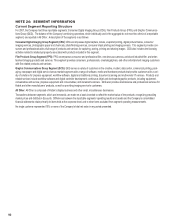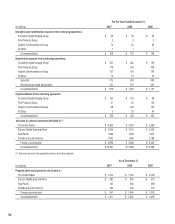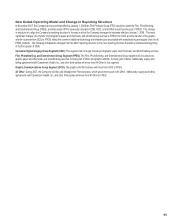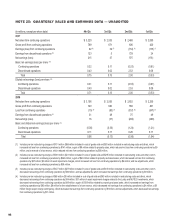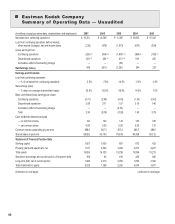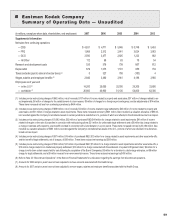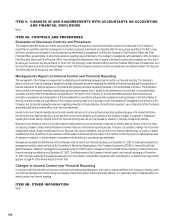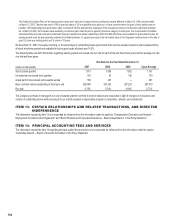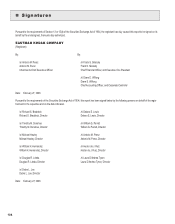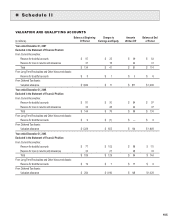Kodak 2007 Annual Report Download - page 101
Download and view the complete annual report
Please find page 101 of the 2007 Kodak annual report below. You can navigate through the pages in the report by either clicking on the pages listed below, or by using the keyword search tool below to find specific information within the annual report.100
ITEM 9. CHANGES IN AND DISAGREEMENTS WITH ACCOUNTANTS ON ACCOUNTING
AND FINANCIAL DISCLOSURE
None.
ITEM 9A. CONTROLS AND PROCEDURES
Evaluation of Disclosure Controls and Procedures
The Company maintains disclosure controls and procedures that are designed to ensure that information required to be disclosed in the Company’s
reports filed or submitted under the Exchange Act is recorded, processed, summarized and reported within the time periods specified in the SEC’s rules
and forms, and that such information is accumulated and communicated to management, including the Company’s Chief Executive Officer and Chief
Financial Officer, as appropriate, to allow timely decisions regarding required disclosure. The Company’s management, with participation of the Company’s
Chief Executive Officer and Chief Financial Officer, has evaluated the effectiveness of the Company’s disclosure controls and procedures as of the end of
the fiscal year covered by this Annual Report on Form 10-K. The Company’s Chief Executive Officer and Chief Financial Officer have concluded that, as of
the end of the period covered by this Annual Report on Form 10-K, the Company’s disclosure controls and procedures (as defined in Rules 13a-15(e) and
15d-15(e) under the Exchange Act) were effective.
Management’s Report on Internal Control over Financial Reporting
The management of the Company is responsible for establishing and maintaining adequate internal control over financial reporting. The Company’s
internal control over financial reporting is designed to provide reasonable assurance regarding the reliability of financial reporting and the preparation of
financial statements for external purposes in accordance with generally accepted accounting principles in the United States of America. The Company’s
internal control over financial reporting includes those policies and procedures that: (i) pertain to the maintenance of records that, in reasonable detail,
accurately and fairly reflect the transactions and dispositions of the assets of the Company; (ii) provide reasonable assurance that transactions are
recorded as necessary to permit preparation of financial statements in accordance with generally accepted accounting principles in the United States of
America, and that receipts and expenditures of the Company are being made only in accordance with authorizations of management and directors of the
Company; and (iii) provide reasonable assurance regarding prevention or timely detection of unauthorized acquisition, use or disposition of the Company’s
assets that could have a material effect on the financial statements.
Internal control over financial reporting cannot provide absolute assurance of achieving financial reporting objectives because of its inherent limitations.
Internal control over financial reporting is a process that involves human diligence and compliance and is subject to lapses in judgment or breakdowns
resulting from human failures. Internal control over financial reporting also can be circumvented by collusion or improper management override.
Because of such limitations, there is a risk that material misstatements may not be prevented or detected on a timely basis by internal control over finan-
cial reporting. However, these inherent limitations are known features of the financial reporting process. Therefore, it is possible to design into the process
safeguards to reduce, though not eliminate, this risk. Because of its inherent limitations, internal control over financial reporting may not prevent or detect
misstatements. Also, projections of any evaluation of effectiveness to future periods are subject to the risk that controls may become inadequate because
of changes in conditions, or that the degree of compliance with the policies or procedures may deteriorate.
Management assessed the effectiveness of the Company’s internal control over financial reporting as of December 31, 2007. In making this assessment,
management used the criteria set forth by the Committee of Sponsoring Organizations of the Treadway Commission (COSO) in “Internal Control-Inte-
grated Framework.” Based on management’s assessment using the COSO criteria, management has concluded that the Company’s internal control over
financial reporting was effective as of December 31, 2007. The effectiveness of the Company’s internal control over financial reporting as of December
31, 2007 has been audited by PricewaterhouseCoopers LLP, the Company’s independent registered public accounting firm, as stated in their report which
appears on page 41 of this Annual Report on Form 10-K.
Changes in Internal Control over Financial Reporting
In connection with the evaluation of disclosure controls and procedures described above, there was no change identified in the Company’s internal control
over financial reporting that occurred during the Company’s fourth fiscal quarter that has materially affected, or is reasonably likely to materially affect, our
internal control over financial reporting.
ITEM 9B. OTHER INFORMATION
None.




